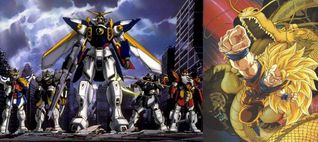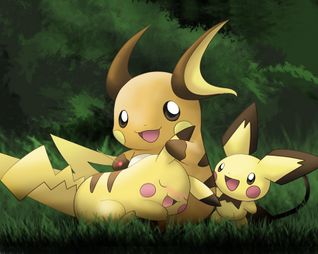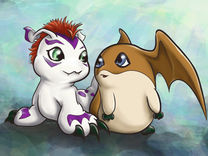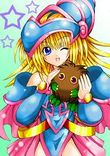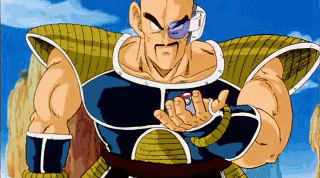Japanese TV series centered around battles where powerful creatures are summoned using some small object that usually has a real-life equivalent of these battles in the form of a game, except in real life, you don't actually get to summon any creatures
 
|
  
|
Japanese TV series centered around battles where powerful creatures are summoned using some small object that usually has a real-life equivalent of these battles in the form of a game, except in real life, you don't actually get to summon any creatures is a new type of franchise recently invented by the Japanese to redirect money from the wallet of young children's parents to their bank accounts. While the franchise is often based on a manga, the TV series and the real-life game(s) tend to play a more prominent role in its popularization.[2]
Origin
As the latest brand of anime to attract a worldwide fanbase, its origins must inadvertently lie in older, more established brands of popular Japanese television. And what better brands to draw from than the mecha genre and the Dragon Ball franchise?
Mecha are large mechanical battlesuits, often termed robots despite them being almost indiscriminately piloted by humans[3], which varyingly appear out of underground bases, aerial transports, huge spaceships, but most notably out of thin air. And often whatever container the mecha are in seems disproportionately small compared to the size the mecha have when they're fighting the enemy in a random city littered with skyscrapers[4], for instance. And then there's the giant monsters these mecha have to face in certain series. In such series, having to fight a monster of formidable size is usually the only reason why there are mecha in it to begin with.[5]
Dragon Ball was the forerunner of Japanese TV series centered around battles where powerful creatures are summoned using some small object that usually has a real-life equivalent of these battles in the form of a game, except in real life, you don't actually get to summon any creatures. It featured dragons being summoned from a collection of orange balls known as "Dragon Balls" for obvious reasons. But because the people who summon these dragons tend to be experts at martial arts and can fire energy beams from their hands and because the dragons were gifted with the godlike power to grant wishes, there was no incentive to make use of the dragons' no doubt awesome fighting abilities.
Now combine all of that with insect collecting, virtual pets, cockfights and the desire to make loads of money and you get this genre.
Plot
Initial series
The series starts by introducing the viewers to the main protagonist, a regular kid, usually pretty naive, not exceptionally smart but certainly not stupid either, invariably an intuitive and forthcoming person with strong ideals who looks rather carefree most of the time, but when things get serious, he[6] gets this really determined look in his eyes.[7] The episode starts out in an environment familiar to the protagonist, but soon the protagonist and the viewers along with him are drawn into the world of [Insert name of franchise here] and a challenger appears. The protagonist is joined by the other members of the gang[8] in the first couple episodes, at least one of which in the very first one. If they are strangers to the protagonist, chances are they start out as adversaries, but quickly bond and become friends. There's at least one girl[9] on the team and one expert in the field of the titular game of the anime, usually geeky looking. Expect to see lots of alternative family structures among the main characters: one of their parents is mysteriously absent/mysteriously died when they were young, they're being raised by their grandparents, they were adopted, stuff like that. Also, be prepared for the typically unrealistic anime haircuts; the protagonists that don't wear some kind of headgear[10] almost invariably have Goku hair[11], sometimes with bits of hair in a different, lighter colour in the front.
In the first couple episodes, the gang establishes their goal[12]: becoming the best, fighting evil forces, or in the best case, both. Sometimes it alternates between the two. Thus begins a life-changing journey through the wonderful world of [Insert name of franchise here]. Speaking of which, the franchise's universe will contain a load of creatures, often referred to as monsters regardless of how monster-like they actually are, which will be forced to battle each other because these battles constitute the most popular sport of the franchise's world[13] and/or because for some reason the fate of the entire world depends on the outcome of these battles. And to keep it family-friendly, these battles practically never result in any deaths. Instead, the monsters faint, turn into an egg or are sent to a gloomy afterlife in the Graveyard. If this setup hasn't disrupted your willing suspension of disbelief yet, congratulations, you are now one of the fans.
As the series progresses, we learn more and more about the franchise's 'mons. There's usually something annoyingly repetitive going on with the creatures' names: recurring suffixes, recurring prefixes, the monsters only being able to say their name, the names including the colour of their eyes etc. The creatures will typically be segregated[14] according to the types/attributes/elements/families/civilizations/whatever you want to call it they're associated with. According to the standard formula of this type of franchise, these types invariably incorporate the four classical elements, earth, water, air and fire, often colour-coded (brown/green, blue, white/lightblue and red respectively) for your convenience. Usually a couple others are added to the mix, like light, darkness, metal, electricity, plant, ghost, the divine, psychic powers and plain old normality. Monsters will also be able to grow stronger; this occurs varyingly by transforming into a more powerful monster, by leveling up, by absorbing power from other entities or by fusing with another monster. The first one is usually referred to as evolution, even though that word meant "gradual change over time"[15] in a distant past where this genre wasn't universally popular yet. And before I forget, because creatures are often based on the same collection of commonly known tropical/prehistoric/mythological wildlife, there are a great deal of similar critters across different franchises. Sometimes this phenomenon may even occur within a single franchise.
As the show progresses, new, more threatening antagonists/villains will rear their ugly/sexy heads.[16] Also, the villains typically include a lot more adults than the protagonist's group, reinforcing the idea that adults are evil. At the end of the series, the evil mastermind will reveal his master plan for world domination, or alternatively, his convoluted scheme to fulfill some personal desire for which he requires the protagonist's power. If the protagonist is also trying to win some kind of major tournament at the time, these two events will likely be connected. Usually, the final opponent in the competition represents the evil mastermind's side. The protagonist proceeds to kick the bad guys' asses and, if we're lucky, a plot twist ensues.
Follow-up series
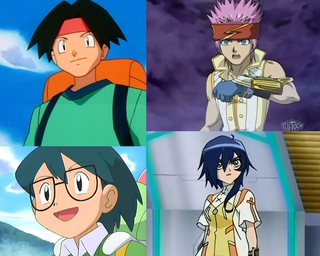
“The show must go on.”
– A phrase originally used by circus ringmasters when animals got loose or performers were hurt, signifying that they valued making profit higher than the physical and psychological well-being of human beings
If the initial series proved to be sufficiently popular among the masses, or if some wealthy Japanese guys just feel like throwing away some of their money, follow-up series are bound to ensue.
Enter the adaptation frenzy
Name of franchise: The Movie[17] plus sequels
M(ore and more m)anga, comics, graphic novels etc.
Name of franchise: The Abridged Series
To paraphrase the Holy Bible:
| “ | In the beginning, God created a whole lot of stuff. Then God made all this stuff differentiate into different kinds of stuff. Then God instilled a seed of life into a certain type of stuff. Then God instilled a seed of intelligence into a certain type of life. But the rareness of the event of this seed of intelligence coming to full fruition ensured that there'd always be a lot of simple, gullible people to be manipulated by more insightful individuals. God had also designed intelligence in such a way that as soon as the seed of intelligence sprouted in a form of life, so would develop a concept of pleasure; and pleasure would become a purpose in and of itself. Thus God ensured the existence of an entertainment industry. Following from all this, it was inevitable that a few relatively smart people'd figure out what kind of franchise would catch on with the masses. As such a franchise spread across the globe, it would become equally inevitable that a number of funny people would simultaneously start abbreviating, enhancing and ridiculing the series in question. The result of this practice would come to be known as "abridged series" and it is this magnificent product of billions years of divinely ordained evolution that constitutes the ultimate reason for this universe's existence. | ” |
Fan fiction and perverted DeviantArt 'art'
Fans of various mainstream series may take it upon themselves to create "fan fiction", that is, a written story[18] of what they think should happen in the plot instead of what is actually intended by the creator. Among the many sub-genres, some notable ones include romance, sex, exploitation, transgressivism, and anything other that concerns one's genitals. These stories are known for their degrading power and strange use of the most notorious characters. Why, even poor old Jigglypuff may be forced into bondage acts.
DeviantArt is an imageboard site used primarily for the same purpose, but is even worse since pictures are used instead of words. Millions of innocent children have been scarred for life by DeviantArt, as they stumbled upon it while looking for 4chan.
Airplanes
No franchise is truly complete until even airplanes have succumbed to the craze. [1]
The franchises[19]
- Megami Tensei, the very first franchise of this genre, which has a video game and anime dating back to no less than 1987. Their 'mons are actually demons, which can be recruited and summoned through a device called a COMP. Though it's pretty well known in Japan, it never got very popular in the Occident. When Pokémon got as popular as it did, they decided to redesign the COMPs into gun-shaped computers called Devil Risers and made a Pokémon-style anime and video games. If you've never heard of it before, that's probably because it's been completely overshadowed by Pokémon the moment the latter franchise entered the scene.
- Pokémon
- Digimon
- Yu-Gi-Oh!
- Beyblade
- Kaijudo
- Medabots
- Bakugan

- Duel Masters has a manga, an anime and a trading card game. It's basically Yu-Gi-Oh! with more God cards and a protagonist with a slightly more realistic hairdo. Also, for some unknown reason, they decided to make the monsters look like fake 3D animations in the anime. The most noteworthy thing about this series is that besides the main male protagonist and the cliché midget nerd, the central team comprises two girls, one of which is both hot and tough. Oh, and the series' evil organization is called P.L.O.O.P. You know, like the sound a little poo makes when it falls into the toilet.[20]
- There's also a shitty scamming
gamesystem based on it, World's worst trolling attempt: an abomination unleashed.
- There's also a shitty scamming
- Battle Spirits a Yu-Gi-Oh rip-off that Bandai made.
- Cardfight!! Vanguard is yet another Yu-Gi-Oh! rip-off.[21] This one was created in a collaboration between the manga artist from Yu-Gi-Oh! R and a technical advisor from Duel Masters.
- Cross Fight B-Daman but not the earlier series
- Kiba
- Legendz
- Monsuno
- Dragon Drive
- Fighting Foodons is what you get when you mix crazy cooking battles with magical cards and stir it up real good.
- Monster Rancher
- Magi-Nation
- Dinosaur King
- Mon Colle Knights and the associated Monster Collection trading card game
- Blue Dragon
- MegaMan NT Warrior and the Mega Man Battle Network video games
- Onmyō Taisenki
- Zatch Bell!
- My-HiME and to a lesser extent its spin-off My-Otome
- Angelic Layer
- There's also Cardcaptor Sakura, a manga/anime made up of a weird mix of this genre and the magical girl genre. It spawned two movies and a couple video games, but there weren't enough cards in it to establish its own trading card game, regrettably.
While all these franchises can arguably be said to be ripping each other off, there are also the truly blatant rip-offs that weren't included in the list above because they only managed to produce a video game: Dokapon and Robopon.
Also, due to the fact that it is an American franchise[22], the mother of all trading card games, Magic: The Gathering, doesn't have its own anime.
And then there's the series that don't use any objects to summon powerful creatures. Instead of the monsters being imprisoned in tiny balls, their awesome power being contained within handheld items or them being sealed away in magical cards, they just travel alongside the protagonist.[23] Additionally, if there's a great deal of creatures to collect, the protagonist in question will conveniently own a ranch or farm where there's plenty of room to stow away monsters whose services aren't required. The most notable examples of this rather rare phenomenon are Dragon Quest Monsters and Narutaru. Some of the franchises that were listed earlier, like Digimon and Monster Rancher, also feature monsters walking side by side with their masters most of the time, but they also prominently feature objects which contain mons or the key to unlock more powerful versions of said mons. Lastly, there are also series where monsters are magically summoned by magic users without the use of any small objects (e.g. Shaman King, JoJo's Bizarre Adventure, The Familiar of Zero, Magical Girl Lyrical Nanoha, Bleach and Naruto, occasionally). These series tend to be less successful as the lack of these objects makes it harder for the fans to identify with the protagonist as they generally lack innate magical abilities and there's no toy or item they can purchase that corresponds to the protagonist's power source to make up for it.[24]
Lastly
The only reason why the subject of Japanese TV series centered around battles where powerful creatures are summoned using some small object that usually has a real-life equivalent of these battles in the form of a game, except in real life, you don't actually get to summon any creatures doesn't have an entry on TV Tropes yet is because the name of the thing is so fucking long.[25] Also, their capitalize-every-word style of titles makes reading very long titles pretty obnoxious. As to why Wikipedia will never have an article on it, it's because original thinking is strictly forbidden around those parts.[26]
Footnotes
- ↑ Warning! Some of these scenes may cause epileptic seizures. Make sure there's a medic in the room before viewing.
- ↑ Probably because a translated manga isn't as appealing to children as a TV series or a video/strategy game is.
- ↑ Which is obviously just to give people someone to identify with when they're playing around with their little Gundam toys. Also, allowing an artificial intelligence to control weaponry is generally a bad idea in fictional universes.
- ↑ Usually Tokyo.
- ↑ Don't even get me started on what lame plot devices the writers come up with to explain how the monsters get so big in the first place.
- ↑ The protagonist is almost invariably male.
- ↑ Sometimes he even becomes a completely different person when battling.
- ↑ Don't worry, it's not a criminal organization.
- ↑ It wouldn't be a proper anime if it didn't have any boobies.
- ↑ And that don't belong to the small group of female protagonists.
- ↑ It's either his normal haircut or his Super Saiyan haircut.
- ↑ Usually referred to as their destiny.
- ↑ The Romans' main form of entertainment was watching animals and gladiators fight in arenas, so it's not that much of a stretch. This also means that all our children are secretly Romans willing to cut through anything that gets in their way with their double-edged swords, however.
- ↑ Though not necessarily in a racist way.
- ↑ Not "starting to glow and instantaneously taking on a different shape".
- ↑ Villains are always polarized. There's no room for inbetweeners.
- ↑ Without the subtitle, English people might be lead to believe that it's not a movie.
- ↑ Both the terms "written" and "story" are used loosely here.
- ↑ Warning! Boring lists ensue.
- ↑ Seriously, what were they thinking?
- ↑ Notice that the title has two exclamation points in it. This must be an omen that a Yu-Gi-Oh! rip-off with three exclamation points is soon to follow.
- ↑ And because making anime-like shows is clearly above Americans' standards.
- ↑ Sounds a lot more humane, wouldn't you say so?
- ↑ Exceptions include series that just include this as an aside with their main focus being on some other popular theme.
- ↑ Seriously, if the title had four more characters, it would be too long due to technical restrictions.
- ↑ Wikipedia defines doubleplusgood thinking as the process of thought that adheres to their perennial slogan: [citation needed].
